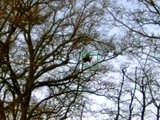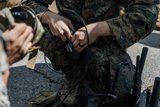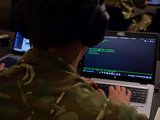WNW Anti-Jam Mode successfully tested on PHOENIX radios
BAE Systems has tested its mid-tier PHOENIX networking radios at Joint Base McGuire-Dix-Lakehurst (Fort Dix) in an effort to enhance the ability of warfighters to securely and reliably communicate battlefield information via jam-resistant waveforms. The company reported positive results on the over-the-air field tests.
BAE Systems is the developer of the Wideband Networking Waveform (WNW) Anti-Jam (AJ) mode for the US Department of Defense. These tests were conducted within the scope of a Cooperative Research and Development Agreement (CRADA) between the US Army Communications-Electronics Research, Development and Engineering Center (CERDEC), and BAE Systems.
PHOENIX radios allow soldiers to communicate voice, data, and video for enhanced battlefield awareness. This family of software-defined radios includes three programmable variants, each of which uses the next-generation, government-owned WNW and Soldier Radio Waveform (SRW), and allows multiple configurations: two-channel with SINCGARS, two-channel, and four-channel.
With the robust WNW, all PHOENIX variants provide full anti-jam modes to protect communications in hostile environments and when using jammers. The off-the-shelf radio system has been developed to offer a low size, weight, and power solution that can be easily integrated with the SINCGARS radio space already allotted on US Army ground combat vehicles.
Christopher A Ager, director of Networked Communications at BAE Systems, said of the tests: ‘Protecting tactical communications is fundamental to maintaining battlefield advantage. Our expertise with the Anti-Jam mode of WNW is evident in the positive results of our field testing at Fort Dix. During this testing, each PHOENIX radio successfully and securely communicated across uneven terrain.’
The CRADA provides industry with unique opportunities to collaboratively work alongside government engineers, allowing BAE Systems access to government facilities and resources at Fort Dix. The Product Director for C4ISR and Network Modernization — a directorate of CERDEC — provided the venue to host, instrument, and observe the BAE Systems-led tests.
BAE Systems is now preparing to conduct additional WNW-AJ tests on networks of up to 30 nodes in the coming months. In November 2012, PHOENIX-2C radios successfully provided tactical networking capabilities during US Army exercises at Fort Huachuca, Arizona, enabling soldiers to communicate more than 20km in moving vehicles, which is double the mid-tier network requirement.
More from Digital Battlespace
-
![Chess Dynamics successfully demonstrates Vision4ce AI-driven tracker]()
Chess Dynamics successfully demonstrates Vision4ce AI-driven tracker
The Vision4ce Deep Embedded Feature Tracking (DEFT) technology software is designed to process video and images by blending traditional computer vision with artificial intelligence (AI) algorithms to present actionable information from complex environments.
-
![Wave Relay devices cleared for security use on commercial systems in industry trend]()
Wave Relay devices cleared for security use on commercial systems in industry trend
Persistent Systems has been cleared by National Security Agency (NSA) to transmit sensitive data on commercial networks. The devices are added to the NSA’s Commercial Solutions for Classified (CSfC) component list which also includes other companies’ products providing the same security.
-
![UK teases cyber spending boost in Strategic Defence Review ahead of “imminent” release]()
UK teases cyber spending boost in Strategic Defence Review ahead of “imminent” release
The release of the UK’s Strategic Defence Review (SDR) has been long promised as mid-year. It is possible it could be as early as 2 June although the UK Ministry of Defence (MoD) continues to play its cards close to its chest.
-
![Intelsat emphasises SATCOM resilience for SOF in contested domains (video)]()
Intelsat emphasises SATCOM resilience for SOF in contested domains (video)
Intelsat outlines how its multi-orbit SATCOM architecture is enhancing connectivity and resilience for special operations forces operating in degraded and contested environments.
-
![US Space Force’s next-generation missile warning system moves forward with $500 million in new contracts]()
US Space Force’s next-generation missile warning system moves forward with $500 million in new contracts
Next-Generation Overhead Persistent Infrared (Next-Gen OPIR) satellites are intended to provide early warning of missile launches from any location worldwide and new ground stations will result in expanded coverage of critical missile warning.























